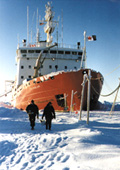The Importance of Sea Ice
Polar sea ice undergoes tremendous changes every year. During the winter, the Arctic ice pack grows to the size of the United States; in the summer, half of the ice disappears. At the other end of the globe, ice covers nearly 98 percent of the Antarctic continent and averages one mile (1.6 kilometers) thick. The sea ice surrounding Antarctica changes in size depending on the season, ranging from roughly four million square miles (10.3 million square km) in February (the Antarctic summer) to 19 million (30.6 million km) in August. So huge is the Antarctic ice sheet that it accounts for 90 percent of the world's ice and 70 percent of its fresh water.
Given the amount of water that sea ice alternately puts into or pulls out of the ocean and the atmosphere, sea ice variability plays a major role in global climate change. During the International Geophysical Year scientists from the United States and the Soviet Union spent entire winters on ice islands in the Arctic, measuring depth, salinity, temperature, and other factors to model the extreme variability of sea ice. Forty years later, NSF-funded researchers repeated much of the work done in the IGY but this time with modern means, greatly improving our understanding of sea ice variability and the connections to climate change.
 From
the fall of 1997 through the fall of 1998, the Canadian ice breaker ship
known as Des Groseilliers was frozen into the Arctic ice pack
for scientific studies related to a multinational project known as
SHEBA, or Surface HEat Budget of the Arctic. NSF, the U.S. Office of
Naval Research, and the Japanese government cooperated in funding this
massive study of heat flow among the water, ice, and air of the
northernmost Arctic. For a full year, researchers documented how ice,
clouds, snow, and the ocean interact and exchange energy. SHEBA
researchers are now off the ice and back in the laboratories to
integrate and analyze the vast amount of data they have collected but
already they have reported a number of surprises.
From
the fall of 1997 through the fall of 1998, the Canadian ice breaker ship
known as Des Groseilliers was frozen into the Arctic ice pack
for scientific studies related to a multinational project known as
SHEBA, or Surface HEat Budget of the Arctic. NSF, the U.S. Office of
Naval Research, and the Japanese government cooperated in funding this
massive study of heat flow among the water, ice, and air of the
northernmost Arctic. For a full year, researchers documented how ice,
clouds, snow, and the ocean interact and exchange energy. SHEBA
researchers are now off the ice and back in the laboratories to
integrate and analyze the vast amount of data they have collected but
already they have reported a number of surprises.
One unexpected finding concerned the salinity of the water. When the scientists first arrived at the Arctic ice pack in October 1997, they discovered that the water was much fresher than it had been when the same area was analyzed 20 years earlier. They concluded that the melting of the ice pack during the summer of 1997 caused the water to be proportionally less salty. Such a change can have serious consequences for marine life as well as for how ocean water circulates and interacts with the atmosphere. [Editor's note: An inaccurate statement about sea ice and rising sea levels has been deleted. We regret the error.]
All of which, of course, raises questions about what is driving sea ice melting and temperature changes. Over the last 100 years, overall global climate has warmed, on average, about 1.3 degrees F (0.74 degrees C) with the Arctic leading the way: Average arctic temperatures increased at almost twice the global average rate in the past 100 years. The Antarctic is warming up, as well. Ice shelves from the western side of the Antarctic Peninsula have been shrinking; according to some reports, the 502-square-mile (1,300 square km) Wordie Ice Shelf disappeared completely between 1966 and 1989.
NSF-funded scientists who participated in the Science Ice Expeditions
(SCICEX) program have confirmed that there is an acceleration in sea ice
shrinkage. The SCICEX program provided the opportunity to use U.S. Navy
submarines for Arctic research during the 1990s. Data from the SCICEX
cruises demonstrate that the Arctic sea ice cover is showing signs of
diminished extent and seasonal duration. What's more, ice observed in
the 1990s was more than three feet thinner compared to measurements
taken two to four decades earlier. Together, the SHEBA and SCICEX
projects have revealed a major climatic factor—shrinking sea ice—that is
now being incorporated into forecasts of global climate variability. If
the ice pack continues to decrease in coverage and thickness,
researchers suggest the possibility of a seasonally near ice-free
Arctic—an area that has been covered by ice for at least
 three million years—and a vastly changed world.
three million years—and a vastly changed world.
What is the source of the warming trend? Part of the challenge in answering this question is learning how to separate the effects of human activity (such as the introduction into the atmosphere of "greenhouse" gases like carbon dioxide) from warming and cooling cycles that occur naturally. In the polar regions, average temperatures have fluctuated on various time scales, from the tens of thousands of years to one hundred thousand years. Further study of ice and sediment cores will provide a more detailed picture of ice sheet behavior during warmer intervals of Earth's history. Because Earth was warmer in the distant geologic past, studies of this complex period should shed light on the future effects of global warming.